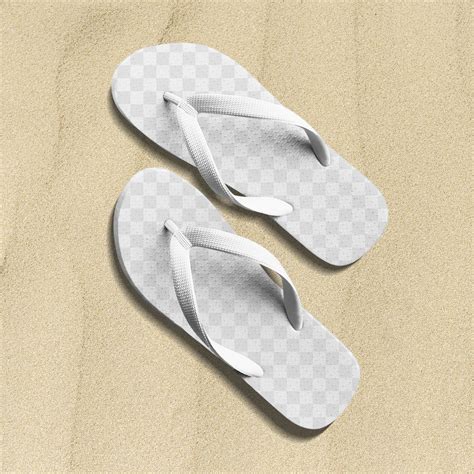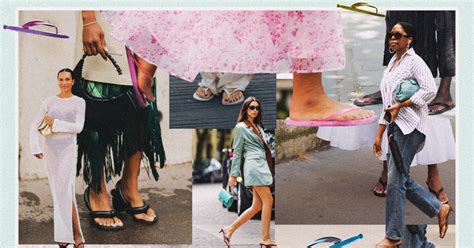
Flip-flops, often considered a fashion faux pas by some, are paradoxically a favored footwear choice among fashion-conscious individuals, lauded for their comfort and versatility despite their detractors.
Despite often being relegated to the realm of casual beachwear, flip-flops have found an unlikely champion in the world of high fashion, embraced by stylists and fashion enthusiasts alike. According to Yahoo Lifestyle, while some individuals strongly dislike flip-flops, citing concerns about foot protection and aesthetics, others view them as a practical and stylish option for various occasions. This divide in opinion highlights the subjective nature of fashion and the evolving role of comfort in contemporary style.
The argument against flip-flops typically centers on their lack of support and perceived lack of sophistication. Detractors often associate them with purely utilitarian purposes, suitable only for the beach or poolside. Concerns about hygiene, particularly in public spaces, also contribute to their negative perception. However, proponents argue that flip-flops have evolved beyond their basic design, with numerous brands offering stylish and supportive options that are suitable for a wider range of settings.
Several factors contribute to the flip-flop’s enduring appeal, including their affordability, breathability, and ease of wear. In warmer climates, they provide a comfortable alternative to closed-toe shoes, preventing overheating and allowing for greater freedom of movement. Furthermore, the sheer variety of designs and materials available—from simple rubber styles to embellished leather versions—allows individuals to express their personal style while enjoying the benefits of this casual footwear. The rise of minimalist fashion trends has also contributed to the flip-flop’s resurgence, as its simple silhouette complements the clean lines and understated aesthetic favored by many contemporary designers and consumers.
Fashion stylists often incorporate flip-flops into their looks to achieve a relaxed, effortless vibe. They can be paired with everything from jeans and t-shirts to dresses and skirts, adding a touch of casual cool to otherwise more formal outfits. The key to successfully styling flip-flops lies in choosing the right design for the occasion and paying attention to the overall aesthetic of the outfit. For example, a sleek leather flip-flop can elevate a simple sundress, while a brightly colored rubber style might be better suited for a beach outing.
The ongoing debate surrounding flip-flops underscores the dynamic nature of fashion trends and the importance of personal preference. While some may continue to view them as a fashion no-no, others will undoubtedly embrace their comfort and versatility, proving that even the most humble footwear can find a place in the world of high style.
The Enduring Appeal and Controversy of Flip-Flops: A Deep Dive
Flip-flops. The mere mention of the word can elicit strong reactions, ranging from nostalgic affection to outright disdain. This simple footwear, often associated with beaches, summer vacations, and casual comfort, has become a surprisingly controversial topic within the fashion world. While some designers and fashionistas embrace the flip-flop’s effortless style, others consider it a sartorial sin, unfit for anything beyond the most informal settings. Understanding this dichotomy requires exploring the historical context, evolving designs, and the multifaceted appeal – and drawbacks – of this ubiquitous shoe.
A Brief History of the Flip-Flop
The origins of the flip-flop can be traced back thousands of years. Ancient Egyptians wore sandals made from papyrus and palm leaves, while similar designs appeared in various forms in Africa and Asia. The Japanese zori, a flat sandal with a thong between the toes, is a direct ancestor of the modern flip-flop. Following World War II, these Japanese sandals were brought to the United States, where they were quickly adopted as casual footwear. The name “flip-flop” is believed to have originated from the sound the sandals make when walking.
The rise of the flip-flop’s popularity in the mid-20th century coincided with the burgeoning surf culture of California. They were inexpensive, easy to wear, and perfectly suited for the beach lifestyle. Over time, flip-flops became a symbol of relaxation and freedom, associated with warm weather and outdoor activities. Brands like Havaianas, which introduced colorful rubber flip-flops inspired by the Japanese zori, played a significant role in popularizing the footwear globally.
The Great Divide: Why Flip-Flops Spark Controversy
Despite their widespread popularity, flip-flops have consistently faced criticism from various quarters. The primary concerns revolve around their lack of support, potential health risks, and perceived lack of style.
-
Lack of Support and Foot Health Concerns: Many podiatrists and health professionals caution against prolonged flip-flop use due to their minimal arch support. The flat design can lead to overpronation, where the foot rolls inward excessively, potentially causing pain in the feet, ankles, knees, and even the back. Furthermore, the lack of protection exposes the feet to dirt, bacteria, and injuries. Walking in flip-flops often requires gripping with the toes to keep them in place, which can lead to strain and muscle fatigue. The Yahoo Lifestyle article references the lack of support, which is a common concern echoed by medical professionals.
-
Style and Aesthetics: Critics often argue that flip-flops are simply not stylish or appropriate for many situations. They are often seen as too casual for professional settings, formal events, or even everyday wear in urban environments. The simple design, often made from rubber or inexpensive materials, can be perceived as cheap and unrefined. Many associate flip-flops with a lack of effort or attention to detail, suggesting that those who wear them are not concerned with their appearance. This perception is further reinforced by the association of flip-flops with beachwear and poolside attire.
-
Hygiene and Safety: Concerns about hygiene also contribute to the negative perception of flip-flops. Open footwear exposes the feet to dirt, germs, and potential injuries. Walking on city streets or in public spaces with flip-flops can increase the risk of cuts, scrapes, and infections. The thong between the toes can also harbor bacteria and cause irritation. Furthermore, flip-flops offer little protection from sharp objects or spills, making them unsuitable for certain environments.
The Flip Side: Why Fashionistas Embrace Flip-Flops
Despite the criticisms, flip-flops have found a surprising following among fashion-conscious individuals. Several factors contribute to their enduring appeal and their occasional embrace by the fashion elite.
-
Comfort and Convenience: The primary reason for the flip-flop’s popularity is its undeniable comfort and convenience. They are easy to slip on and off, making them ideal for quick errands, casual outings, or simply relaxing at home. In warm weather, they provide a breathable alternative to closed-toe shoes, preventing overheating and allowing the feet to stay cool. The freedom and ease of movement they offer are particularly appealing in today’s fast-paced world.
-
Versatility and Adaptability: While traditionally associated with casual wear, flip-flops have become increasingly versatile. Designers have experimented with different materials, embellishments, and styles, creating flip-flops that are suitable for a wider range of occasions. Leather flip-flops, for example, can be paired with dresses or skirts for a more polished look, while embellished flip-flops can add a touch of glamour to a casual outfit. The key is to choose the right style for the occasion and to pair them with appropriate clothing.
-
Minimalist Aesthetic: The rise of minimalist fashion has also contributed to the flip-flop’s resurgence. Their simple silhouette and understated design complement the clean lines and unadorned aesthetic favored by many contemporary designers. In a world saturated with over-the-top trends and flashy accessories, flip-flops offer a refreshing alternative – a return to simplicity and functionality.
-
Effortless Style: For some, flip-flops embody a sense of effortless style – a relaxed and carefree attitude that is both appealing and aspirational. They suggest a lack of pretension and a willingness to prioritize comfort over conformity. This attitude resonates with those who value authenticity and individuality. The “I don’t care, but I actually do care” vibe.
-
Nostalgia: Flip-flops evoke a sense of nostalgia for many, reminding them of carefree summer days, beach vacations, and simpler times. This emotional connection can override rational objections to their style or practicality. The Yahoo Lifestyle article subtly hints at this nostalgic element, acknowledging the comfort and familiarity that many associate with flip-flops.
The Evolution of Flip-Flop Design
The flip-flop has undergone a significant transformation since its humble beginnings. Designers have experimented with different materials, shapes, and embellishments, creating a diverse range of styles that cater to different tastes and occasions.
-
Materials: While rubber remains the most common material for flip-flops, other options include leather, suede, canvas, and even high-tech synthetic materials. Leather flip-flops offer a more sophisticated look and are often more durable than rubber versions. Suede flip-flops provide a soft and comfortable feel, while canvas flip-flops are a lightweight and breathable option for warm weather.
-
Support and Comfort Features: Recognizing the health concerns associated with traditional flip-flops, many brands have introduced models with enhanced support features. These include contoured footbeds, arch support, and cushioning to provide greater comfort and stability. Some flip-flops even incorporate orthotic technology to help correct foot alignment and alleviate pain.
-
Embellishments: From simple beads and sequins to elaborate embroidery and metal accents, embellishments can transform a basic flip-flop into a statement piece. Embellished flip-flops are often worn for special occasions or to add a touch of glamour to a casual outfit. The Yahoo Lifestyle article implicitly acknowledges this trend by noting the flip-flop’s adoption by fashion-conscious individuals, suggesting a movement beyond basic rubber styles.
-
Platform Flip-Flops: Platform flip-flops add height and a touch of drama to the classic design. These styles are often popular among those who want to make a fashion statement.
-
Designer Collaborations: High-end designers have also embraced the flip-flop, collaborating with established brands to create limited-edition collections. These collaborations often feature unique designs, high-quality materials, and elevated price points.
Styling Flip-Flops: Dos and Don’ts
Successfully incorporating flip-flops into your wardrobe requires careful consideration. Here are some general guidelines:
-
Do: Choose the right style for the occasion. Rubber flip-flops are best suited for the beach, pool, or casual outings. Leather or embellished flip-flops can be worn for more dressy occasions.
-
Do: Pay attention to the overall aesthetic of your outfit. Flip-flops should complement your clothing, not clash with it.
-
Do: Ensure your feet are well-groomed. Pedicures are a must when wearing open-toed shoes.
-
Don’t: Wear flip-flops to formal events, professional settings, or situations where safety is a concern.
-
Don’t: Wear flip-flops that are worn out or damaged. Replace them regularly to avoid injury and maintain a polished appearance.
-
Don’t: Wear flip-flops if you have foot problems or injuries. Consult with a podiatrist for appropriate footwear recommendations.
The Future of Flip-Flops
The flip-flop’s future appears secure, albeit with ongoing evolution. As consumers become increasingly conscious of comfort, sustainability, and versatility, the flip-flop is likely to adapt to meet these demands. Expect to see more flip-flops made from recycled materials, incorporating ergonomic designs, and blurring the lines between casual and dressy footwear. The debate surrounding their place in the fashion world will likely continue, but the flip-flop’s enduring appeal ensures that it will remain a staple in wardrobes around the globe.
Frequently Asked Questions (FAQs)
-
Are flip-flops bad for your feet?
- Flip-flops can be detrimental to foot health if worn for extended periods or if they lack adequate support. The flat design and lack of arch support can lead to overpronation, foot pain, and other musculoskeletal issues. However, some flip-flops are designed with contoured footbeds and arch support, offering better comfort and stability. It is advisable to choose supportive styles and limit prolonged wear.
-
What are the best flip-flops for arch support?
- Several brands offer flip-flops with enhanced arch support features. Look for styles with contoured footbeds, deep heel cups, and built-in orthotics. Brands like Vionic, Oofos, and Birkenstock (though technically sandals, they offer similar open-toe convenience with superior support) are known for their supportive flip-flops. Reading customer reviews and consulting with a podiatrist can also help you find the best option for your specific needs.
-
Can I wear flip-flops to work?
- Whether flip-flops are appropriate for work depends on the workplace’s dress code and the nature of your job. In general, flip-flops are considered too casual for professional office environments or client-facing roles. However, they may be acceptable in more relaxed or creative workplaces. It is always best to check with your employer or HR department to clarify the dress code policy.
-
How do I clean flip-flops?
- The cleaning method for flip-flops depends on the material. Rubber flip-flops can be cleaned with soap and water. Use a brush or sponge to scrub away dirt and grime, then rinse thoroughly and allow them to air dry. Leather flip-flops should be cleaned with a leather cleaner and conditioner to prevent drying and cracking. Canvas flip-flops can be spot-cleaned with a mild detergent and water.
-
Are flip-flops considered fashionable?
- The fashionability of flip-flops is subjective and depends on individual style preferences and current trends. While some consider them a fashion faux pas, others embrace their comfort and versatility. Designers have created stylish flip-flops using various materials, embellishments, and designs, making them suitable for a wider range of occasions. Ultimately, whether flip-flops are fashionable depends on how they are styled and the overall aesthetic of the outfit.
The controversy surrounding flip-flops highlights the evolving nature of fashion and the increasing emphasis on comfort and practicality. While traditionalists may continue to view them as inappropriate for certain settings, their undeniable appeal and adaptability ensure that they will remain a staple in wardrobes worldwide. The key is to choose the right style for the occasion and to prioritize foot health and safety.









